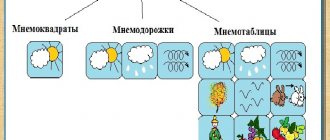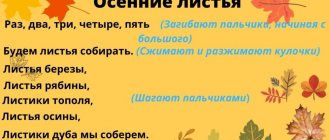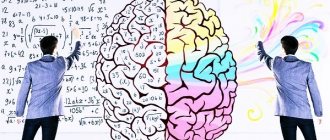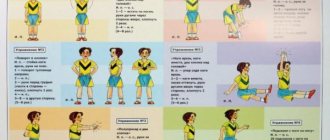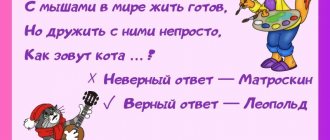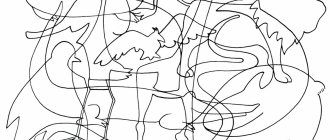Mnemonics for preschoolers “Mnemotables for words”
Mnemonics for preschoolers “Mnemotables for words”
Mnemonics is a set of rules and techniques that facilitate the process of memorizing information.
The use of mnemonics in preschool age occupies a large place. In order to develop certain skills and abilities in children from a very early age, so-called mnemonic tables are introduced into the educational process (diagrams; in kindergartens, algorithms for the processes of washing, dressing, setting tables, caring for indoor plants, etc. are often used. In their developmental classes to improve the cognitive sphere, I use “Mnemotables for words” (mushroom, cup, winter, autumn, etc.).
This helps solve the following learning tasks:
1. Development of coherent speech;
2. Converting abstract symbols into images (transcoding information);
3. Development of fine motor skills of the hands;
4. Development of basic mental processes - visual-spatial memory, attention, figurative and verbal-logical thinking; helps to master the techniques of memorization and composing stories.
Working with the mnemonic table:
1. Consideration of the mnemonic table.
2. Recoding of information.
3. Reproducing the table from memory.
www.maam.ru
Mnemotables “Favorite Tales”
Good day! I really love doing theatrical activities with my students. In addition to performing at holidays and in theater productions, it is very important that group rooms have the necessary conditions for the development of children's creative potential. I present to you cards - mnemonic tables.
A mnemonic table is one of the most popular and effective techniques (mnemonics) that can be used to facilitate the process of memorizing and reproducing information by preschoolers, developing thinking and speech. In my mnemonic tables, there are sequential images in which the content of fairy tales is encrypted. When an adult listens to a fairy tale, the child remembers it not only by ear, but also by visual perception. He can retell a familiar fairy tale.
On the back of the cards I placed the fairy tale itself in the form of text. It is intended for a teacher, if suddenly he is not familiar with this fairy tale or has forgotten some details.
I took pictures of fairy tales from the Internet, but mainly from this site: https://www.detiam.com/
Next, I want to offer my colleagues the opportunity to use my work.
Wolf and 7 kids. Table DOCX / 2.8 MB Wolf and 7 kids. Text DOCX / 14.18 KB Zayushkina's hut. Text DOCX / 14.93 Kb Zayushkina's hut. Table DOCX / 2.8 MB Kolobok. Table DOCX / 4.27 MB Kolobok. Text DOCX / 19.28 Kb Who said meow. Suteev. Table DOCX / 22.51 KB Who said meow. Suteev. Text DOCX / 753.89 Kb Chicken Ryaba. DOCX table / 3.65 MB Chicken Ryaba. Text DOCX / 12.63 Kb Chanterelle with a rolling pin. Table DOCX / 796.68 KB Chanterelle with a rolling pin. Text DOCX / 17.42 KB Little fox-sister. Table DOCX / 542.95 KB Little fox-sister. Text DOCX / 16.21 KB Masha and the Bear. Table DOCX / 687.65 Kb Masha and the Bear. Text DOCX / 17.88 KB Comb cockerel. Table DOCX / 774.23 Kb Comb cockerel. Text DOCX / 18.04 Kb Under the mushroom. Suteev. Text DOCX / 17.19 Kb Under the mushroom. DOCX table / 1.01 MB Turnip. DOCX table / 5.51 MB Turnip. Text DOCX / 14.51 KB Teremok. Table DOCX / 605.37 KB Teremok. Text DOCX / 16.55 Kb Three kittens. Suteev. Text DOCX / 18.4 Kb Three kittens. Table DOCX / 539.71 Kb Three bears. Table DOCX / 706.85 Kb Three bears. Text DOCX / 16.98 Kb The Three Little Pigs. Table DOCX / 1.1 MB Three Little Pigs. Text DOCX / 24.51 Kb Chicken and duckling. Suteev. Text DOCX / 17 Kb Chicken and duckling. DOCX table / 577.2 KB
LiveInternetLiveInternet
Learning poems with children of senior preschool age using mnemonic tables.
Mnemonics is a system of various techniques that facilitate memorization and increase memory capacity by forming additional associations. Such techniques are especially important for preschoolers, since mental problems are solved with the predominant role of external means, and visual material is absorbed better than verbal material.
Mnemonic tables are diagrams that contain certain information. Mastering the techniques of working with mnemonic tables significantly reduces training time and at the same time solves problems aimed at:
— development of basic mental processes - memory, attention, imaginative thinking;
- recoding of information, i.e. transforming abstract symbols into images;
— development of fine motor skills of the hands with partial or complete graphic reproduction.
Mnemonic tables serve as didactic material in the development of coherent speech in children, for enriching vocabulary, when teaching how to compose stories, retellings, guessing riddles, and memorizing poetry.
The goal is to develop visual and auditory memory, to activate the vocabulary on a specific lexical topic.
When using visual modeling in our work, we teach children:
- obtain information, conduct research, make comparisons, draw up a clear internal plan for mental actions and speech statements;
- formulate and express judgments, draw conclusions;
- the use of visual modeling has a positive effect on the development of non-speech processes: attention, memory, thinking.
Using supporting drawings to teach memorizing poems captivates children and turns the activity into a game.
This method is most effective for older preschoolers. Since, in preschool age, visual-figurative memory predominates and memorization is involuntary. The visual image that the child retains after listening, accompanied by viewing the drawings, allows him to remember the text much faster.
At the first stage, you should select supporting pictures for the poem for each line. Pictures should be bright and recognizable. When reading a poem, the pictures are placed on a magnetic board. After reading, children reproduce the poem using reference pictures.
The peculiarity of the method is that it uses symbols rather than images of objects, which makes it much easier for children to find and memorize words, since the symbols are as close as possible to the speech material.
Stages of working on a poem:
- The teacher reads the poem expressively.
- Informs that the child will learn this poem by heart.
- Then he reads the poem again using the mnemonic table.
- The teacher asks questions about the content of the poem, helping the child understand the main idea.
- The teacher finds out which words are incomprehensible to the child and explains their meaning in a form accessible to the child.
- The teacher reads each line of the poem separately. The child repeats it using a mnemonic table.
- The child recites a poem based on a mnemonic table.
Read more…
Middle group. Junior preschool age. Children 4 - 5 years old
The development of speech in children of the middle group of preschool age in play activities through mnemonic techniques. The relevance of this topic is determined by the fact that there is a social order of society for the formation of a personality capable of organizing interpersonal interaction and solving communicative problems, which ensures its successful adaptation and socialization in modern...
Summary of a lesson on speech development in the middle group using mnemonics “The Bunny came to visit us” LESSON SUMMARY on speech development in the middle group using mnemonics “The Bunny came to visit us”
. Prepared by: E.V. Panina, teacher at MDOAU No. 126, Orenburg. Scenario summary of the final lesson Progress of the lesson: 1. Introductory part: Organizational moment. Word game...
